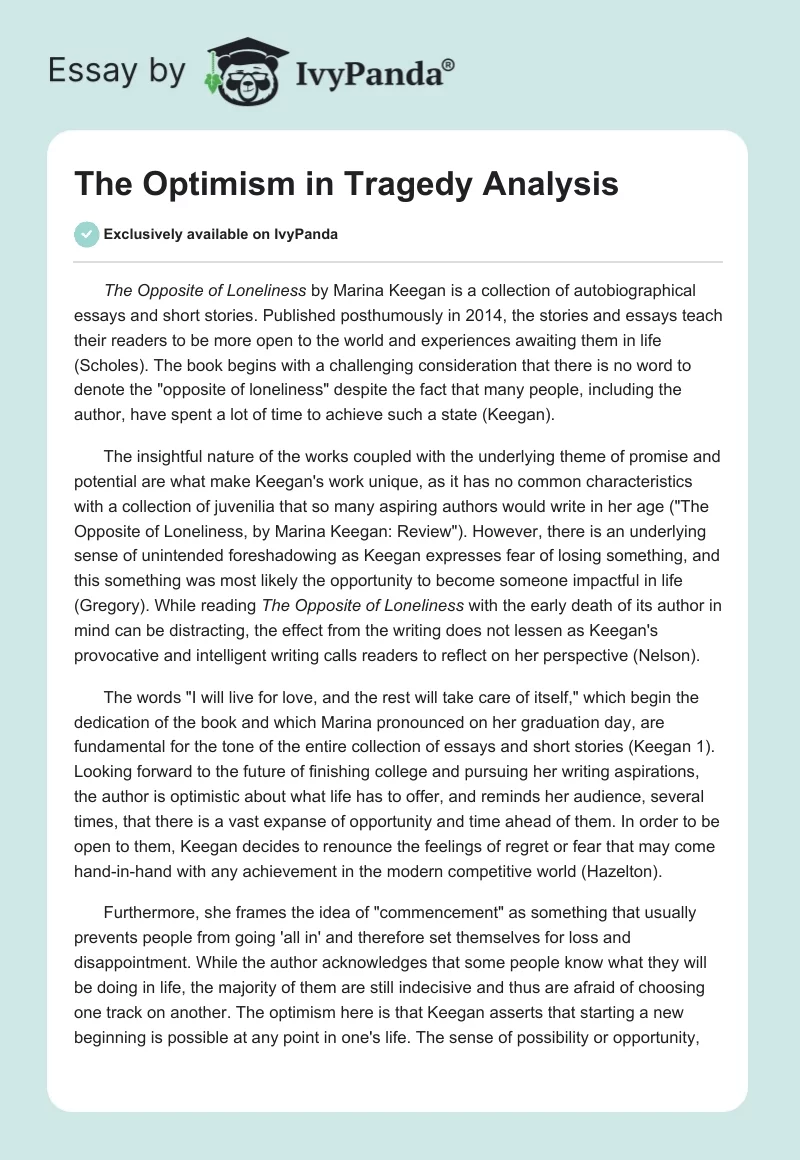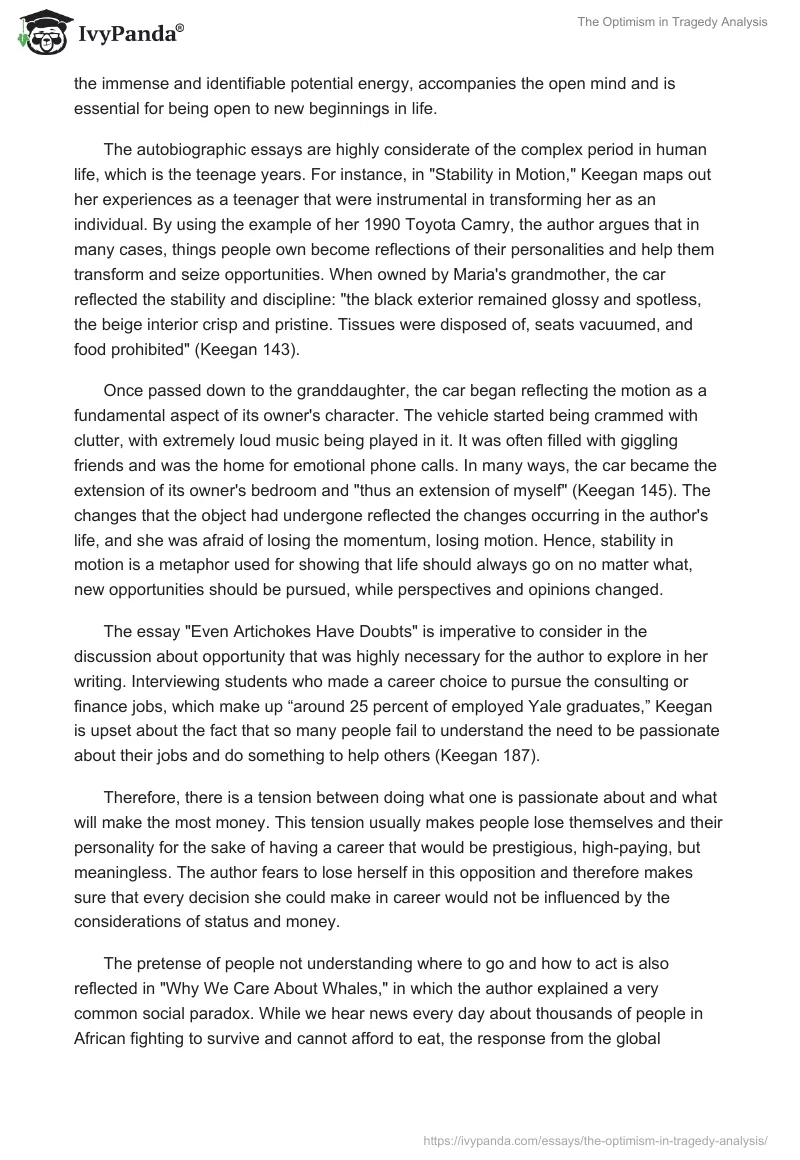The Opposite of Loneliness by Marina Keegan is a collection of autobiographical essays and short stories. Published posthumously in 2014, the stories and essays teach their readers to be more open to the world and experiences awaiting them in life (Scholes). The book begins with a challenging consideration that there is no word to denote the “opposite of loneliness” despite the fact that many people, including the author, have spent a lot of time to achieve such a state (Keegan).
The insightful nature of the works coupled with the underlying theme of promise and potential are what make Keegan’s work unique, as it has no common characteristics with a collection of juvenilia that so many aspiring authors would write in her age (“The Opposite of Loneliness, by Marina Keegan: Review”). However, there is an underlying sense of unintended foreshadowing as Keegan expresses fear of losing something, and this something was most likely the opportunity to become someone impactful in life (Gregory). While reading The Opposite of Loneliness with the early death of its author in mind can be distracting, the effect from the writing does not lessen as Keegan’s provocative and intelligent writing calls readers to reflect on her perspective (Nelson).
The words “I will live for love, and the rest will take care of itself,” which begin the dedication of the book and which Marina pronounced on her graduation day, are fundamental for the tone of the entire collection of essays and short stories (Keegan 1). Looking forward to the future of finishing college and pursuing her writing aspirations, the author is optimistic about what life has to offer, and reminds her audience, several times, that there is a vast expanse of opportunity and time ahead of them. In order to be open to them, Keegan decides to renounce the feelings of regret or fear that may come hand-in-hand with any achievement in the modern competitive world (Hazelton).
Furthermore, she frames the idea of “commencement” as something that usually prevents people from going ‘all in’ and therefore set themselves for loss and disappointment. While the author acknowledges that some people know what they will be doing in life, the majority of them are still indecisive and thus are afraid of choosing one track on another. The optimism here is that Keegan asserts that starting a new beginning is possible at any point in one’s life. The sense of possibility or opportunity, the immense and identifiable potential energy, accompanies the open mind and is essential for being open to new beginnings in life.
The autobiographic essays are highly considerate of the complex period in human life, which is the teenage years. For instance, in “Stability in Motion,” Keegan maps out her experiences as a teenager that were instrumental in transforming her as an individual. By using the example of her 1990 Toyota Camry, the author argues that in many cases, things people own become reflections of their personalities and help them transform and seize opportunities. When owned by Maria’s grandmother, the car reflected the stability and discipline: “the black exterior remained glossy and spotless, the beige interior crisp and pristine. Tissues were disposed of, seats vacuumed, and food prohibited” (Keegan 143).
Once passed down to the granddaughter, the car began reflecting the motion as a fundamental aspect of its owner’s character. The vehicle started being crammed with clutter, with extremely loud music being played in it. It was often filled with giggling friends and was the home for emotional phone calls. In many ways, the car became the extension of its owner’s bedroom and “thus an extension of myself” (Keegan 145). The changes that the object had undergone reflected the changes occurring in the author’s life, and she was afraid of losing the momentum, losing motion. Hence, stability in motion is a metaphor used for showing that life should always go on no matter what, new opportunities should be pursued, while perspectives and opinions changed.
The essay “Even Artichokes Have Doubts” is imperative to consider in the discussion about opportunity that was highly necessary for the author to explore in her writing. Interviewing students who made a career choice to pursue the consulting or finance jobs, which make up “around 25 percent of employed Yale graduates,” Keegan is upset about the fact that so many people fail to understand the need to be passionate about their jobs and do something to help others (Keegan 187).
Therefore, there is a tension between doing what one is passionate about and what will make the most money. This tension usually makes people lose themselves and their personality for the sake of having a career that would be prestigious, high-paying, but meaningless. The author fears to lose herself in this opposition and therefore makes sure that every decision she could make in career would not be influenced by the considerations of status and money.
The pretense of people not understanding where to go and how to act is also reflected in “Why We Care About Whales,” in which the author explained a very common social paradox. While we hear news every day about thousands of people in African fighting to survive and cannot afford to eat, the response from the global community is predominantly non-existent. Although, when a whale is washed up on the beach, people panic, and with the sense of emergency, try to get it back into the ocean.
Keegan writes, “I worry sometimes that humans are afraid of helping humans” (152). The paradox is established because of distance as Africa is far away, and thus its problems are not as visible and noticeable. Whales, however, can be washed up on shores anywhere with an ocean shore, making the problem more visible and dramatic. Here, Keegan proceeds with arguing that it is imperative to help anyone who requires support. The lives of those suffering from injustice or poverty are in the hands of those who have the opportunity to change the social narrative and become valuable members of society.
Throughout the exploration of the non-fiction essays by Marina Keegan, one cannot but not to notice the universal message of not only growing up but becoming one’s own person. The tension that the author faces is trying to connect to the world around her, failing in some instances, and succeeding in others. This struggle is known to any person because everyone had a growing up stage in his or her life. Moreover, young people also are commonly frustrated with their parents who do not allow them to grow up by being over-protective. In “Against the Grain,” which explored Marina growing up with celiac disease, Keegan writes, “there was no escaping it. Summer camp and sleepovers were the same routine – counselors and parents embarrassing me with special snacks tucked away by my mom” (162).
The common ground that the author was trying to reach with her audience was associated with the need to become better people that could help others. Thus, it is not surprising why Keegan explored such an unusual profession as an exterminator in the character of Tommy, who often joked about his occupation in order to avoid becoming the subject of someone else’s ridicule. When choosing their careers, people are often governed by what is profitable at a certain period of time or what would guarantee stability. Exterminators will always be needed to provide services to restaurants, shops, and private homes.
However, one has to have a passion for working in this area for decades, which was true for Tommy: “Why stop?” He shrugs. “I just love it” (Keegan 178). The story teaches the audience not to be embarrassed about their occupations because every job has a purpose. If one is doing it with passion and a few jokes here and there, it has a purpose and would inevitably bring benefit to other people.
To elaborate on the topics chosen as the focus for her essays, Keegan was keen to use vibrant and straightforward language. It is fresh and free of complicated vocabulary that would make the pieces pretentious and thus less interesting. This aspect of her work is particularly important to note because so many young people try to sound older when they write to be taken more seriously. For Keegan, seriousness is not a priority; instead, the dialogues and the narratives are structured in such a way that readers can recognize themselves in writing. When exploring the teenage years as one of the most complex but exciting periods in life, it is essential to hear the perspective of a teenager and not someone pretending to be older.
She is not afraid of using caps letters and exclamations and employs the teenage vernacular to her advantage: “AHHHH ALICE’S ESSAY IS SO GOOD OH MY GOD… ELISA’S IS SO GOOD TOO! Oh my gosh” (Keegan 14). Such a manner of writing is both refreshing and enticing as readers are not perplexed by unfamiliar phrases and jargon that is hard to understand. However, the style of writing is not juvenile to any extent as evidence in her short essay “The Art of Observation”: to be fascinated by, nothing to esteem, nothing to romanticize in this everyday examination of our immutable solipsism.” (Keegan 204). The immaculate structure of the sentences shows the author’s dedication to the subject matter.
The tension between the author, who was growing up to become a writer, and the world around her is a familiar theme that so many people face at some point in their lives (Kristof). The refreshing perspective that Keegan managed to offer her readers goes far beyond the challenge of growing up as the author teaches its audience that aging is a part of living, that it is worth to try harder to pursue a dream career, that their voice as individuals and citizens matters, as well as the fact that everyone is jealous of someone or something (Charbonnier). All of these topics intertwine together to create Keegan’s story, which is sad and optimistic at the same time.
The insightful nature of The Opposite of Loneliness, coupled with a refreshing look on life, makes Marina Keegan’s tragic story heartbreaking (James). However, when reading her quick and witty prose, one develops a sense of optimism for life that is hard to come by in other literary works. Despite the tensions and the struggles of growing up, Keegan’s stories and essays install a sense of new beginnings and a positive outlook on the future.
Works Cited
Charbonnier, Clemence. “What Marina Keegan’s ‘The Opposite of Loneliness’ Taught Us About Life.” The Culture Trip. 2016. Web.
Gregory, Alice. “Reviewing the Unreviewable. How to Assess the Promising, Posthumous Work of a 22-Year-Old.” The New Republic. 2014. Web.
Hazelton, Clair Kohda. “The Opposite of Loneliness by Marina Keegan review – a far reaching legacy.” The Guardian. 2015. Web.
James, Susan Donaldson. “Marina Keegan’s Parents Tell Boyfriend: Honor Her by ‘Embracing Life’.” ABC News. 2012. Web.
Keegan, Marina. The Opposite of Loneliness: Essays and Stories. Scribner, 2014.
—. “Keegan: The Opposite of Loneliness.” Yale Daily News, 2012. Web.
Kristof, Nicholas. “Her First, and Last, Book.” The New York Times. 2014. Web.
Nelson, Laura. “Marina Keegan: Yale graduate’s boyfriend faces charges in crash.” Los Angeles Times. 2012. Web.
Scholes, Lucy. “The Opposite of Loneliness Review – Marina Keegan’s life cut short.” The Guardian. 2014. Web.
“The Opposite of Loneliness, by Marina Keegan: Review.” National Post. 2014. Web.


